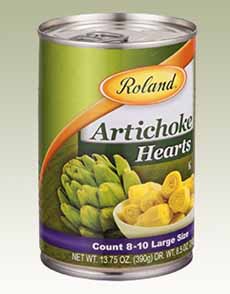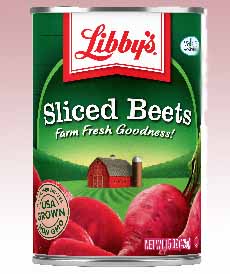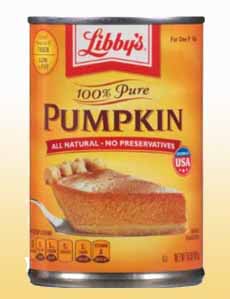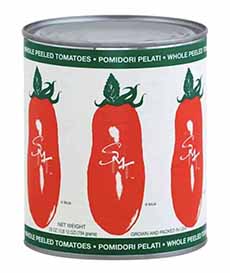|

[1] Artichoke hearts: low in calories, great in salads (photo © Roland Foods).

[2] Black beans, garbanzos (chickpeas), kidney beans, and other varieties save time (photo © Bush’s Beans).

[3] You can find canned beets both sliced and whole (photo © Libby’s Vegetables).

[4] Fresh corn is at its peak for just 2-3 months a year. Canned corn kernels stand in well in recipes (photo © Libby’s Vegetables).

[ ] Canned pumpkin has both sweet and savory uses (photo © Libby’s Vegetables).

[] San Marzano canned tomatoes: the best tomatoes in a can (photo © San Merican).

[ ] Our favorite canned sardines: Bela Olhao (photo © Bela Brand Seafood).
|
|
It’s National Canned Foods Month. Can you name the canned foods in your pantry? Ours contains nutritious and shelf-stable* canned foods which, by definition, also have a longer shelf life* than frozen versions.
In alphabetical order, the list of our personal favorite canned foods follows.
> The history of canned food. Would you believe it started with Napoleon Bonaparte?
Artichoke Hearts. We pop these into salads and spinach-artichoke dip, casseroles, omelets, pasta, pizza, and scores of other recipes.
Asian Foods. Bamboo shoots, bean sprouts, coconut milk, water chestnuts, and others easily come together for a quick Asian dinner.
Beans. Who hasn’t used canned beans? Black beans, garbanzos (chickpeas), kidney beans, pinto beans, and the rest are versatile and packed with protein, fiber, and nutrients—and the cheapest source of protein. We use them in dips (including hummus), salads, sides, soups, stews, and vegan and vegetarian dishes. White cannellini beans are one of our favorites to add to soups and stews. Check out the different types of beans.
Beets. We love beets, and sometimes we have the energy to peel and cook fresh beets. Otherwise, canned beets work wonders. Buying canned beets allows you to enjoy their flavor and nutrition in a fraction of the time and for a fraction of the price. They are also a colorful addition to salads, cheese sandwiches, and vegetable sandwiches. A borscht hack: Blend them with plain yogurt, fresh dill, and salt and pepper.
Broth. Beef, chicken, and vegetable broths are good for everything from sipping to cooking grains, poaching foods, as a base for soups and stews, pan sauces and to lighten cream sauces, in stuffing, noodle bowls, for starters.
Chiles. You can find mild to hot chile peppers in cans. We add them to burgers and sandwiches, burritos and other Tex Mex, dips, grain bowls, rice and other grain sides, rice dishes (jambalaya, risotto), salads, soups, and stews.
Chili. When we want a quick lunch or dinner, a can of chili with grated Cheddar, chopped onions or scallions, and a garnish of sour cream or yogurt is one of our go-to’s. But there’s more! Use chili in baked potatoes with sour cream and scallions, for chili burgers and dogs, chili cheese fries, Tex-Mex (burritos, nachos, tacos), chili cheese fries, layered Mexican dip, polenta—even as a pasta and pizza topping.
Corn. When local corn is out of season, we used canned corn. It delivers the same sweet taste and crunchy kernels for corn fritters, corn muffins, cream corned, mixed with grains, into salads and soups, and as a side dish. Check out esquites, elote-like salad made with corn kernels.
Fish. What would America’s lunches be without canned tuna? Anchovies, clams, mackerel, mussels, oysters, trout, salmon, and sardines keep those cans of tuna company. For nostalgia (and omega 3-6-9 fatty acids), we like to make our mother’s salmon croquettes (salmon cakes) recipe for an occasional dinner. And when we receive a windfall, we buy the most luxurious canned fish: a tin of caviar.
Hearts Of Palm. They’re one of our luxury foods, price-wise. But they taste so good in salads, and the calories are so low. Check out our luxury salad recipe.
Mushrooms. When we’ve forgotten to buy fresh mushrooms, we reach for canned mushrooms. (Another option, though beyond the can: dried mushrooms, reconstituted.)
Nuts. We keep a can of mixed nuts for unexpected drop-ins for beer, cocktails, and wine. You can also toss them into salads and grain dishes that need a bit of interest.
Olives. Of course.
Pineapple. When we’re out of fresh fruit but need something for our cottage cheese or yogurt, canned pineapple chunks do the trick. And, as with so many canned foods, you can pop them into salads, and even atop a pizza with bacon, American ham, or prosciutto.
Pumpkin. Whether it’s pumpkin purée or pumpkin pie filling†, these are standards in our kitchen. You can also serve the purée as a side, in a pasta sauce, pancakes, or soup, in pumpkin dip (sweetened with sugar and cinnamon for a cookie dip), baking, PSLs, or smoothies. Have some left over? Add it to chili, curry, hummus, or oatmeal.
Soup. For years we steered away from canned soups. Lentil, tomato, and split pea soups were our favorites. Although a great convenience food, we checked the label and found it to be packed with salt and corn syrup. More recently, we’ve discovered healthier brands that are just tomatos and water. We add seasonings as we like, from a bit of salt and pepper to fresh herbs.
Tomatoes. Crushed, diced, or whole, canned tomatoes are a boon—not only when fresh tomatoes are out of season, but as a money saver. We use them in pasta sauce, of course, but also in egg dishes (omelet sauce, shakshuka), dips, pasta and pizza sauce, poaching and braising liquid, simmer sauce, and soup base.
While other canned foods, like carrots and peas, are O.K., we prefer frozen to canned. And to us, green beans take on an iffy flavor.
Coming up: March is National Frozen Food Month.
READ THE NUTRITION LABELS
Here’s what to avoid in canned foods:
Additives. The fewer ingredients, the better. Look up articles on food additives: There’s a lot to know.
Fat: No more than 3 grams of saturated fat per serving.
Salt: No more than 2,300 mg of sodium per day. Canned beans, soups, and vegetables tend to have a lot.
Sugar: Hidden sugar, whether it’s agave, apple sauce, brown or white granulated sugar, corn syrup, fruit juice, honey, maple syrup, (the different types of sweeteners. For a daily allotment, women should consume only 6 teaspoons (25 grams or 100 calories) and men o more than 9 teaspoons (36 grams or 150 calories).
|






